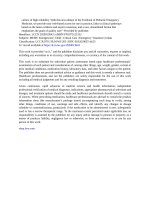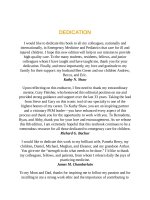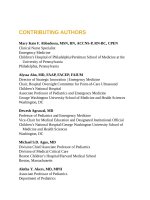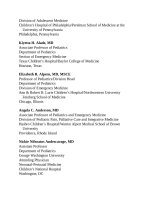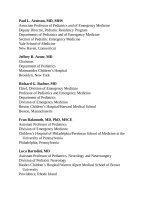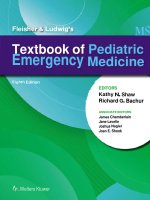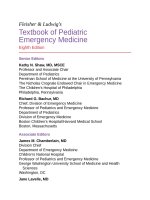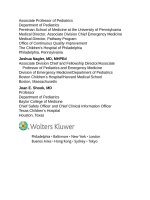Pediatric emergency medicine trisk 810
Bạn đang xem bản rút gọn của tài liệu. Xem và tải ngay bản đầy đủ của tài liệu tại đây (202.68 KB, 4 trang )
FIGURE 105.1 Infraorbital and inferior alveolar main nerves supply the teeth.
Intraoral examination. A good light is essential to inspect the color and quality
(i.e., fluctuance or induration) of the lips, gingiva (gums), buccal mucosa, floor of
the mouth, tongue, and palate. The gingiva should be pink, firm, and stippled
(like a grapefruit skin). The mucosa of the cheeks and floor of the mouth should
be pink, moist, and glassy in appearance. The masseter muscle should be palpated
by rolling it between fingers placed intra- and extraorally. Using a gauze pad, the
clinician should hold the tongue and lift it gently to better view and examine its
dorsal, ventral, and lateral surfaces. Lifting the tongue also allows for a thorough
examination of the floor of mouth. Using the thumb and index finger, the
clinician should palpate the alveolar ridge in all four quadrants for any swelling,
discontinuity, or mobility of the soft tissues and underlying bone. The palate
should be examined for any swelling or tenderness. Any soft tissue swelling,
ecchymoses, and/or hematoma should be noted. Any inflamed, ulcerated, or
hemorrhagic areas, as well as any foreign bodies (e.g., tooth fragments) or
denuded areas of bone should be documented. Next, the oral cavity should be
inspected for any missing, displaced, mobile, tender, or fractured teeth. These
findings are discussed in more detail in subsequent sections.
Radiographic examination. Radiographs are a valuable supplement to the
clinical examination. However, in a child with acute orofacial/dental injuries this
may be difficult and reserved for a dental office. A chest radiograph may be
required if an avulsed tooth is not located. Panoramic radiographs or computed
tomography (CT) scans may be indicated to assess for jaw fracture.
SOFT TISSUE INJURY
CLINICAL PEARLS AND PITFALLS
The soft tissues and bones of the lower and midface are well
vascularized and bleed profusely when injured.
Lacerated soft tissues must be evaluated for any debris, foreign body,
or tooth fragment.
Current Evidence
Hemorrhage is best controlled by direct pressure and when needed, by ligating
any vessels that are easily seen. However, vessels of the face often retract when
severed making them difficult to visualize. If there is extensive blood loss, the
patient should be assessed for signs of shock (see Chapter 10 Shock ). The injured
area should be thoroughly examined for a foreign body such as a tooth fragment.
This may include obtaining a soft tissue radiograph or bedside ultrasound before
suturing when a foreign body is suspected. Infection and poor wound healing are
potential sequelae of such an oversight.
Goals of Treatment
The primary goal for treatment of soft tissue injury is to achieve hemostasis. The
highly vascular tissue in and around the mouth can lead to significant blood loss
with seemingly mild injuries. Recognizing any embedded foreign materials (e.g.,
debris, or tooth fragments) is essential to allow wound healing and reduce the
likelihood of complications. Injuries to the buccal mucosa and inner lip are rarely
of cosmetic concern given rapid wound healing with minimal risk of scarring.
Vermilion border injuries require meticulous alignment for optimal cosmetic
outcome, while select intraoral lesions may not require any repair at all.
Clinical Considerations
Management of soft tissue injuries of the oral cavity follows the same emergency
care principles used for extraoral soft tissue injuries. Injuries to the lip result in
significant swelling after minor trauma. Lacerations of the tongue and frenum
bleed profusely because of the richness of their vascularity. However, ligating
specific vessels is usually unnecessary because bleeding almost always stops with
direct pressure and careful suturing. Frenum lacerations often heal spontaneously
without suturing. When a laceration in the oral cavity is more than 6 hours old,
decisions regarding primary closure need to consider the relative risk of
secondary infection.
Management
Suturing. Suturing the lip must be done carefully to achieve a precise
approximation of the edges of the vermilion border to avoid a disfiguring scar. If
necessary, the lip must be sparingly debrided. Wounds are generally closed with
5-0 or 6-0 sutures. Nylon sutures may be used in cooperative teenagers; however,
fast-absorbing sutures are preferred in younger children given the potential
challenge of subsequent suture removal. Through and through and other deep lip
lacerations require closure in multiple layers, beginning with approximation of
the orbicularis oris muscle using 4-0 chromic and then 5-0 or 6-0 sutures (as
above) for the skin and vermilion border. Most superficial tongue lacerations heal
without suturing. When necessary, tongue lacerations are usually sutured with 4-0
chromic in superficial wounds and with 3-0 chromic in deeper wounds. With
tongue lacerations, it is important to consider the excessive muscular movements
that pull at the sutures; therefore, tongue sutures should be made deep into the
musculature (see Chapter 110 Minor Trauma ).
Orthodontic trauma. Young patients are frequently undergoing orthodontic
treatment, and trauma can result in loosening of wires or ligatures that are
attached to orthodontic brackets or bands. Acutely, the emergency physician can
bend the wire away for analgesic purposes and to avoid further soft tissue injury.
Once this is temporarily addressed, arrangements for urgent dental evaluation can
be pursued. Loose wires can be covered with softened wax or removed to allow
the traumatized soft tissues to heal. If no discomfort is noted and no loose foreign
bodies are present, definitive treatment can be delayed until the patient can be
seen by an orthodontic specialist.
Postanesthesia soft tissue trauma. Young children may injure oral soft tissues
(lips, intraoral mucosa, or tongue) after administration of local anesthesia for a
dental procedure. The child may be numb for several hours postprocedure. This
provides an opportunity for injury, which will appear as a whitish ulceration and
is very painful. A common site for this is the lower lip ( e-Fig. 105.1 ). Rarely
is this type of injury associated with infection. Standard over-the-counter pain
medications and keeping a soft, bland diet are sufficient until the wound heals,
typically in 1 to 2 weeks.
Electrical Burns
Electrical burns occur when children bite on electrical cords. The saliva in the
mouth acts as a conductor to complete the circuit. Although the commissure of
the mouth is most likely affected, the tongue, alveolar ridge, and floor of the
mouth are occasionally involved. Most children with these injuries can be
managed as an outpatient. A bland, soft, cold diet is initially recommended. If a
child refuses oral intake, dehydration may ensue and the administration of
intravenous fluids may be required. Meticulous oral hygiene using a toothbrush
with or without toothpaste should be performed three to four times per day, as
well as hydrogen peroxide and water (1:1) rinses in a cooperative child. With
severe burns of the lips and mouth, labial artery bleeding may occur 5 to 8 days
after the injury. Although admission to the hospital for wound management has
been utilized, the delayed presentation of this late complication makes this
impractical. The clinician should instruct the parent on the method for digitally
compressing the artery if bleeding were to occur. To prevent scarring down of the
commissure, electrical burns of this area require the fabrication of an intra- or
extraoral device to separate the upper and lower segments during healing ( eFig. 105.2A,B ).
TRAUMATIC DENTAL INJURIES
CLINICAL PEARLS AND PITFALLS
Avulsed permanent teeth must be reimplanted immediately while
primary teeth are generally not reimplanted.
Displaced teeth should be repositioned as soon as possible.
Teeth with exposed pulpal tissue require urgent dental treatment.
Fractured posterior teeth may have an associated mandibular fracture.
Current Evidence
The International Association of Dental Traumatology has detailed, evidencebased guidelines for the management of dental trauma which are updated
periodically and can be found online (see References). Focused recommendations
